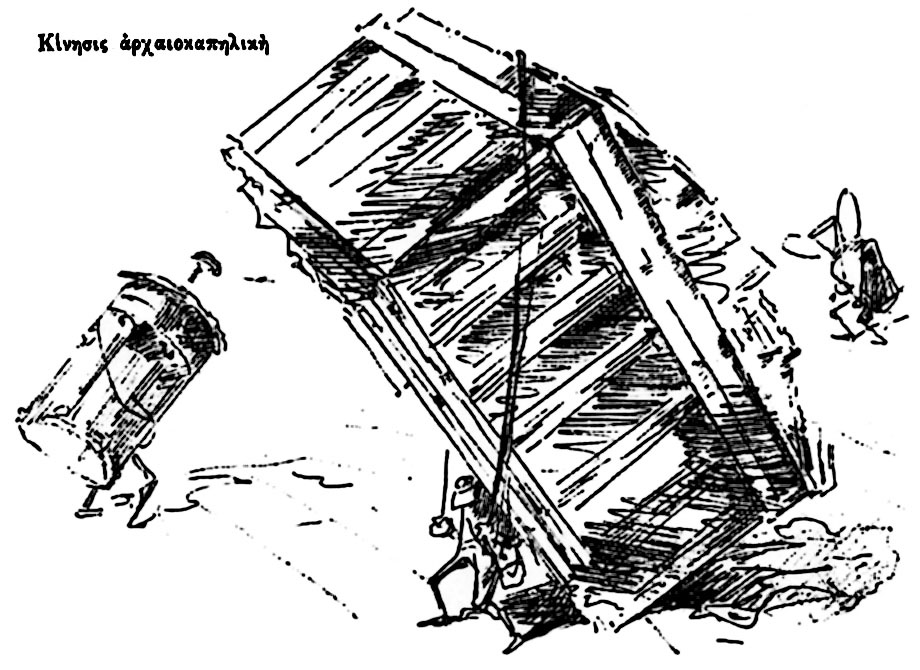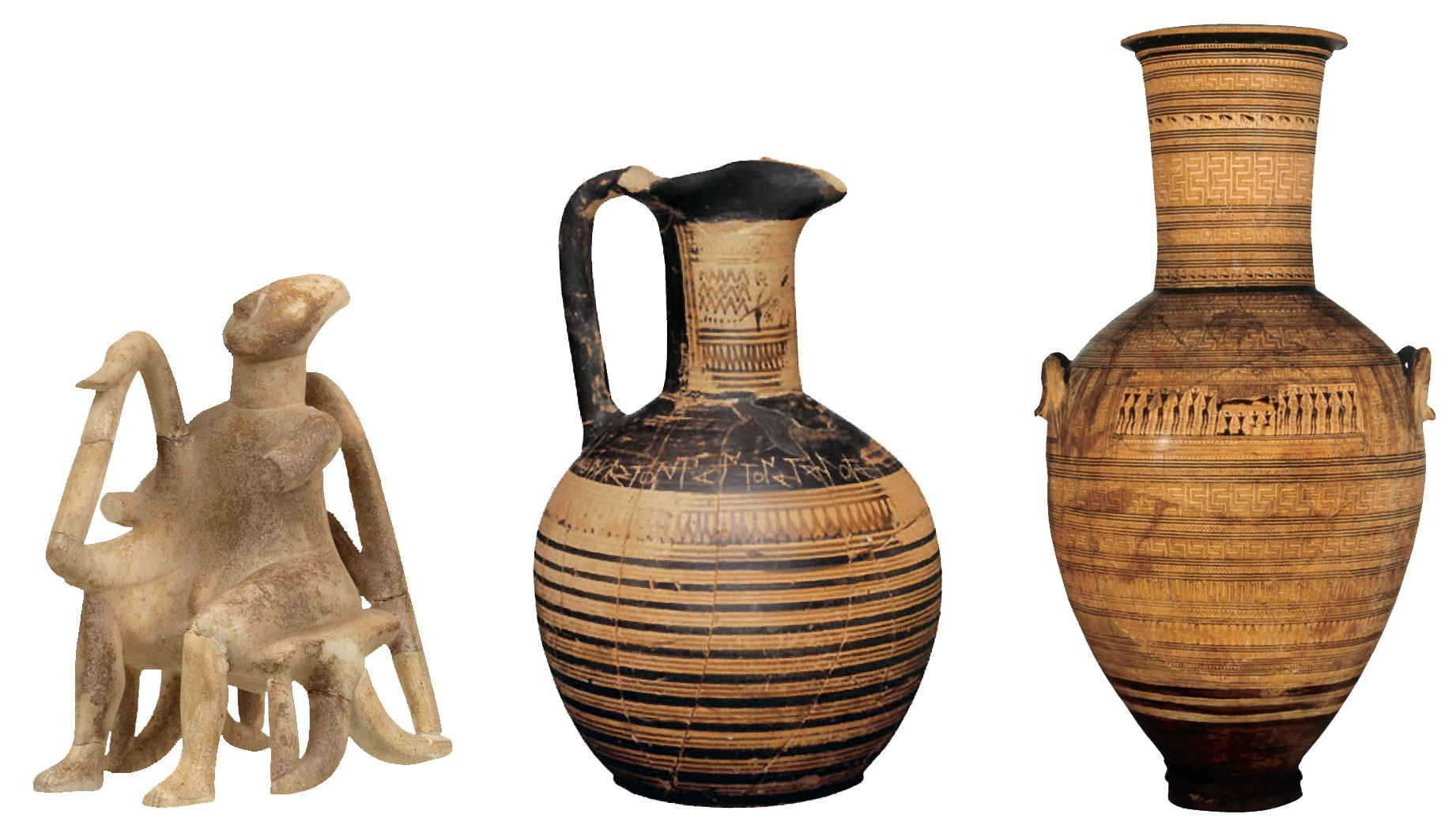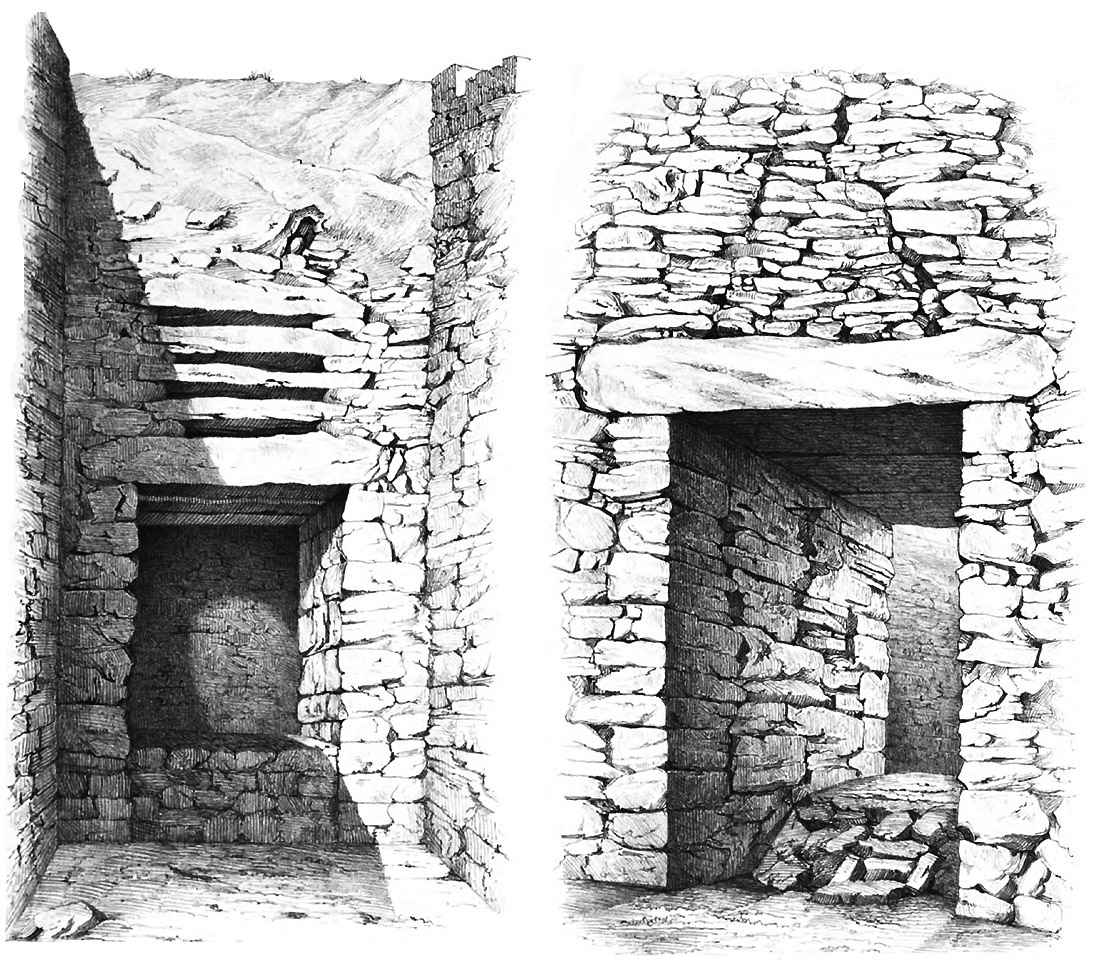“I have already given orders to all the tomb robbers of Athens, who dig up old tombs all over Attica for the vases found in them, that whenever they find an intact skull or indeed any bones they should bring them to me in exchange for a good price, and they do so.”
Professor Athanasios Rhousopoulos to Professor George Rolleston (18/30 August 1871)
So far I have tried to give an overview of my research and to present one of the many protagonists involved in the 19th-century antiquities trafficking in Greece, namely the grand collector-academic art dealer, Professor Athanasios Rhousopoulos. Although individuals such as Rhousopoulos were directly involved in excavations they most frequently relied on a network of secondary dealers, diggers and tomb robbers as made clear by the quotation above. These individuals appear in the archival records under various names. For example, they are often mentioned as “εκχωματαί” or “εργολάβοι των χωμάτων” (“earth removers” or “earth contractors”). With increasing frequency most of them became known as “τυμβωρύχοι”. Although literally meaning “grave diggers”, this term had already in antiquity acquired a negative connotation namely that of “grave robbers”. All these individuals, along with the dealers, would often appear as a group in the 19th-century reports as “αρχαιοκάπηλοι” – “retail dealers in antiquities” – a term that from the middle of the 19th century became synonymous to “illicit antiquities traffickers”.

In the second half of the 19th century more than 50 antiquities dealers and diggers operated in Athens, some of whom were registered and conducted their trade openly, while others were unregistered and tried to hide their traces as much as they could.[1] I count here only those who systematically engaged in the trafficking of antiquities since there are many more who performed similar activities but knowledge of their actions remains largely elusive. In addition to the Athenian dealers, there was also a vast network of individuals operating outside the Greek capital, who, although not necessarily systematic traffickers, were either encouraged and sponsored by or collaborated with the collectors and dealers so that the flow of antiquities to the Athenian market was kept steady. And while Athens was a major location for trafficking Greek antiquities, a number of them were also trafficked directly, or via middlemen, through Paris – the heart of European antiquities trafficking in the second half of the 19th century.
The activities of these dealers and private diggers were often so openly conducted that even guide books to Athens would advertise them in an attempt to whet the appetite of the antiquarians, travelers and tourists who visited the Greek capital: “many [antiquities] are still found annually in the classic soil of the city and its environs”,[2] including a great number of graves which “provided the Athenian dealers in antiquities with copious supplies of vases”.[3]
Since the Greek antiquities law of 1834 permitted conditionally the conduct of private excavations (i.e. excavations on private land after the approval of the General Superintendent of Antiquities of Greece), landowners were often willing to lease their land to “earth contractors” or “tomb diggers”. People who were lawfully or quasi-lawfully “tomb diggers” one day by permission of the general Ephor could the next day (or, with increasing frequency, simultaneously!) act unlawfully as tomb robbers. And since private owners had the right to sell antiquities found on their land and negotiate prices with potential buyers, they increasingly tried to sell them to the highest bidder – most often a collector, an art dealer or one of the agents of the major European museums residing in or visiting Athens for this very purpose.
But who were these private diggers and earth contractors? Despite the fact that these individuals were responsible for some of the earliest excavations in 19th-century Greece and for the discovery of some of the most spectacular objects now adorning Greek, European and American museums their names are hardly ever mentioned.
Ioannis Palaiologos from Athens was one such dealer-digger-contractor. An experienced excavator and prolific antiquities trafficker, he developed his “expertise” by participating as a digger in the official Archaeological Society excavations at the Kerameikos with Professor Rhousopoulos in the early 1860s. Active in Attica, central Greece, the Peloponnese and the Cyclades, Palaiologos’s activities can be traced from the 1850s to around 1900 – a period that also witnessed a boom in the number of visitors to Greece who now wanted to get some ancient memorabilia with them before returning home.[4] From his house/shop in Odos Adrianou in downtown Athens, he would often trade high-profile objects, and although his prices were far from exorbitant, he was making considerable profit. He was a well-known source for antiquities in Athens and was probably the most active Athenian dealer for the sale of early Cycladica and Geometric objects, among numerous other categories of artifacts. Originating from an old Athenian family, he had the means to buy or rent land for his archaeological activities (though clearly lacking the language skills, academic training, intellectual rigor and social standing of Rhousopoulos). The French archaeologist, dealer, and agent for numerous European museums, Olivier Rayet (1847–1887), who had dealings with Palaiologos and knew him quite well, describes him as “un des chercheurs d’antiques les plus expérimentés d’Athènes”.[5]

Palaiologos appears frequently in the archives of Panagiotis Eustratiades (1815–1888), the superintendent of antiquities of Greece between 1863 and 1884. Eustratiades bought numerous objects from the dealer and gave him permission to excavate, but when the Athenian digger acted without authorization, due to his eagerness to discover antiquities, the superintendent tried to stop him.[6] Although Palaiologos was arrested and fined a number of times, he was able to continue uninterruptedly his antiquities trafficking until around 1900. Since the archaeological service was at the time literally led by one man, the superintendent himself, Eustratiades wanted to keep good relations with the Athenian antiquities dealers, who, after all, were the most productive excavators of the time. The superintendent often had to rely on the dealers’ good will (rather than obligation, as specified by the law) to report their excavations and alert him on significant new discoveries. And they occasionally did so – for example, Palaiologos was the discoverer of the Menidi tholos tomb, one of only four Mycenaean tholoi known in Attica and among the few intact tholoi in the Aegean. While the Athenian dealer was looking for ancient graves in December 1872 in an attempt to re-supply his antiquities stock, he stumbled upon the intact tomb – a discovery he promptly announced to the authorities.[7] Interestingly, just two months earlier he had been arrested and fined for digging without authorization in the same area.[8]

That Palaiologos, like all the Athenian dealers of his time, was engaged in illicit activities is beyond doubt. But in many instances he was also operating lawfully or quasi-lawfully as did most of the “earth contractors” and “private diggers” at the time. As it was common practice back then, the finds from these excavations were occasionally – but even then not in their entirety – presented for sale to the Greek state as specified by the first antiquities law in force between 1834 and 1899. Most frequently, however, objects from “private excavations” were sold to collectors and dealers (such as Rhousopoulos and Lambros) or foreign agents (such as Charles Merlin, Gustav Hirschfeld, Olivier Rayet and numerous others). As a result objects from Palaiologos’s excavations are now, not only in Athens, but in several major European museums (and, through later sales, in American collections, such as the MFA in Boston).
Perhaps somewhat surprisingly, Palaiologos was one of those early private diggers whose work, supported largely by market demands than the advancement of knowledge, contributed unreflectively to the periodization of Greek archaeology, gave a better understanding of the stratigraphical data[9] and through the surfacing of some outstanding objects led to a more systematic study of Greek archaeology. He operated in a period that witnessed the transformation of archaeology as a discipline and the progressive professionalization of the antiquities market in Greece. Had he lived a few decades later, Palaiologos would have easily become one of the finest foremen in one of the many big archaeological projects that took place in Greece.[10]
[1] Other dealers, in the period 1850–1900, include the Lambros family; the Drakopoulos family; the Nostrakis family; N. Polychronopoulos; A. Erneris; A. Xakoustis; I. Diligiannis; V. Xydis; P. Kaliniotis; A. Margaritis; C. Christopoulos; E. Geladakis; E. and G. Triantaphyllos; A. Stelakis; S. Anastasopoulos; I. Lembesis; D. Bellos; G. Giagias; M. Roussos; C. Margianakis; K. Lekkas; C. Malandrinos; G. Kotzomanis; P. Velimezis; G. Eustathiadis; S. Tsangarolas; M. Bouloukos; G. Manolakos; G. Yannacopoulos, and many more.
[2] Baedeker, K. (ed.) 1873. Italy: Handbook for Travellers. Part III. Southern Italy, Sicily, and excursions to the Lipari Islands, Tunis, Sardinia, Malta and Athens (4th edition), Leipzig, p. 341.
[3] Baedeker, K. (ed.) 1909. Greece: Handbook for Travellers (4th revised edition), Leipzig, p. 126.
[4] For a meta-narrative interpretation of these ancient “memorabilia” and their lifecycle in the 19th century
see the story of the “Marathon spearheads” now at the Pitt Rivers Museum, in the University of Oxford.
[5] Rayet, O. and Collignon, M. 1888. Histoire de la Céramique Grecque, Paris, pp. 23–24; full references about Palaiologos’s 1871–1872 outer Kerameikos excavations in Galanakis, Y. 2011. “An unpublished stirrup jar from Athens and the 1871–2 private excavations in the Outer Kerameikos”. Annual of the British School at Athens 106, pp. 167-200.
[6] E.g., Eustratiades Archive (Athens Archaeological Society): December 23, 1864, no. 122; March 29, 1865; October 9, 1872, no. 1341; December 14, 1872, no. 1372.
[7] The discovery was first reported on December 8/20, 1872.
[8] Eustratiades Archive (Athens Archaeological Society), October 9, 1872, no. 1341.
[9] E.g., in 1872 when George Rolleston, the medical doctor, university professor and curator of the anatomical department of the University of Oxford, asked Rhousopoulos to send him one of the earliest ancient skulls from Athens, the Greek professor went into some lengths to securely date the stratigraphy of the skull based on the depth of the grave and the pot that accompanied it (an 11th-century BC stirrup jar): “this is the skull which I consider it to be of the 8–9th century BC, as I deduce from the pot with which it was found…and from the depth of the tomb. The tomb was found underneath another tomb of the 5th century BC, as was made clear to me by the pots. The tomb [with the skull] was found at a depth of 6-7m making it older than the 7th century BC…Looking closely at the pots [of this period], which are the oldest in Attica and generally in Greece, I date [the skull] to the 8–9th century BC…it may even be older.” (Rhousopoulos to Rolleston, 17 May 1874). This detail shows Rhousopoulos’s awareness of the stratigraphic sequence of the archaeology of Athens at a time when knowledge of such things was still limited. This particular skull came from Palaiologos’s 1871–1872 outer Kerameikos excavations. “Since the excavation is private, I bought a number of unusual objects and pots. Above all, I ordered the tomb digger to take care of the skulls and bones.” (Rhousopoulos to Rolleston 22 April/4 May 1872). The correspondence is discussed in detail in Galanakis, Y. and Nowak-Kemp, M. 2013. “Ancient Greek Skulls in the Oxford University Museum, Part II: The Rhousopoulos-Rolleston Correspondence”, Journal of the History of Collections 25:1 (also available here).
[10] A good example here is the Cypriot Grigoris Antoniou who worked in numerous excavations in the East Mediterranean and was Arthur Evans’s foreman at Knossos. Born in Larnaca, he “had learned in a jeunesse orageuse spent in tomb-robbing in Cyprus how to remove the most fragile objects without breaking them” (Evans, J. 1943. Time and Chance, London, p. 340). Evans remarked that the “life-long application to his congenial pursuit on early Cypriote sites made him [Antoniou] probably the most expert tomb-hunter of the Levant”. Also described as “a superman among foremen”, Antoniou exemplifies how a “tomb hunter” could potentially turn, with the development of archaeology, into one of the first skilled archaeological workers who with their expertise have since contributed immensely to the discovery of the past.
